外研版初中英语说课稿(好)
- 格式:doc
- 大小:19.50 KB
- 文档页数:8

英语外研社版说课稿尊敬的各位评委、老师,大家好。
今天我要说的是外研社版英语教材中的一课,主题是“Friendship”,这是针对初中一年级学生的课程。
本课旨在通过多种教学活动,让学生理解友谊的重要性,学习如何建立和维护友谊。
教学目标:1. 知识目标:学生能够理解并运用与友谊相关的词汇和句型。
2. 技能目标:学生能够通过听力、口语、阅读和写作活动,提高英语交际能力。
3. 情感态度与价值观目标:学生能够认识到友谊的价值,学会珍惜和维护友谊。
教学重点:- 与友谊相关的词汇和表达方式。
- 描述朋友之间互动的句型。
教学难点:- 正确使用描述友谊的复杂句型。
- 在实际情境中运用所学知识进行交流。
教学方法:- 情景教学法:通过创设情境,让学生在实际语境中使用英语。
- 合作学习法:鼓励学生分组合作,通过讨论和角色扮演来练习语言技能。
教学过程:1. 导入(Lead-in)- 开始课程时,通过展示一些朋友间互动的图片,激发学生对友谊话题的兴趣。
2. 词汇教学(Vocabulary Teaching)- 教授与友谊相关的词汇,如:loyal(忠诚的)、supportive(支持的)、caring(关心的)等。
3. 听力练习(Listening Practice)- 播放一段关于友谊的对话,让学生听并回答问题,以检验他们对词汇的理解和听力技能。
4. 口语练习(Speaking Practice)- 学生分组进行角色扮演,模拟朋友间的对话,使用所学词汇和句型。
5. 阅读材料(Reading Material)- 提供一篇关于友谊的短文,让学生阅读并讨论文章中的观点。
6. 写作活动(Writing Activity)- 学生写一篇短文,描述他们对友谊的看法或分享一个关于友谊的故事。
7. 总结(Summary)- 课程结束时,总结本课所学内容,并强调友谊在人生中的重要性。
8. 作业布置(Homework Assignment)- 要求学生写一封信给朋友,表达感激之情或分享一个快乐的回忆。
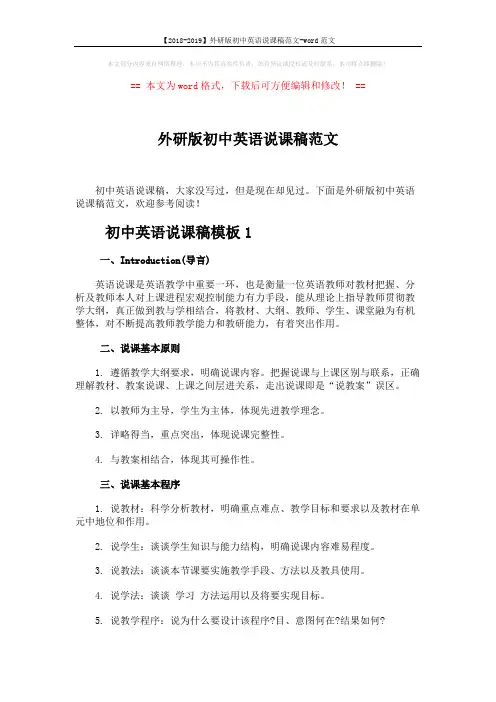
本文部分内容来自网络整理,本司不为其真实性负责,如有异议或侵权请及时联系,本司将立即删除!== 本文为word格式,下载后可方便编辑和修改! ==外研版初中英语说课稿范文初中英语说课稿,大家没写过,但是现在却见过。
下面是外研版初中英语说课稿范文,欢迎参考阅读!初中英语说课稿模板1一、Introduction(导言)英语说课是英语教学中重要一环,也是衡量一位英语教师对教材把握、分析及教师本人对上课进程宏观控制能力有力手段,能从理论上指导教师贯彻教学大纲,真正做到教与学相结合,将教材、大纲、教师、学生、课堂融为有机整体,对不断提高教师教学能力和教研能力,有着突出作用。
二、说课基本原则1. 遵循教学大纲要求,明确说课内容。
把握说课与上课区别与联系,正确理解教材、教案说课、上课之间层进关系,走出说课即是“说教案”误区。
2. 以教师为主导,学生为主体,体现先进教学理念。
3. 详略得当,重点突出,体现说课完整性。
4. 与教案相结合,体现其可操作性。
三、说课基本程序1. 说教材:科学分析教材,明确重点难点、教学目标和要求以及教材在单元中地位和作用。
2. 说学生:谈谈学生知识与能力结构,明确说课内容难易程度。
3. 说教法:谈谈本节课要实施教学手段、方法以及教具使用。
4. 说学法:谈谈学习方法运用以及将要实现目标。
5. 说教学程序:说为什么要设计该程序?目、意图何在?结果如何?6. 说板书设计:谈谈板书设计根据和理由,力求体现说板书设计程序性、概括性和艺术性。
四、注重说课信息和反馈与总结说课对象可以是专家、同行甚至是学生。
向说课对象征询意见、获取信息,力求不断改进和提高。
初中英语说课稿范文2Hello, everyone. Today I’m very pleased to have an opportunityto talk about some of my teaching ideas. My topic is life in the oceans taken from Lesson 63 of Unit 16 in SEFC(2). It is made up of four parts.Part 1 My understanding of this lessonThe analysis of the teaching material:This lesson is a reading passage. It plays a very important partin the English teaching of this unit. Lesson 62 and Lesson 63 are a whole unit. By studying Lesson 63, Ss can improve their reading ability, learn more about the sea and the life in the oceans. At the same time, we should get the students to understand some difficult sentences to comprehend the passage better. The Ss should do some listening, speaking and writing, too. Of course, the Ss shouldreceive some moral education. Let the Ss understand the sea better, love the sea and save the sea and the life of the sea.Teaching aims:1. Knowledge aim: Understand the main idea of the text.2. Ability aim: Retell the text in their own words.3. Emotional aim: Make the Ss love the life of the sea and dosomething to stop it being polluted.Key points / Teaching important points:How to understand the text better.Teaching difficult points:1. Use your own words to retell the text.2. Discuss the pollution of the sea and how to save the sea.Something about the Ss:1. The Ss have known something about the sea and sea life through the Internet and other ways.2. They are lack of vocabulary.3. They don’t often use English to express themselves andcommunicate with others.4. Some Ss are not active in the class because they are afraid of making mistakes.Part 2 My teaching theories, methods and aidsBefore dealing with this lesson, I’ll do my best to carry out thefollowing theories: Make the Ss the real masters in class while theteacher himself acts as director; Combine the language structures with the language functions; Let the students receive some moral education while they are learning the English language.Teaching method:Double activities teaching methodQuestion-and-answer activity teaching methodWatch-and-listen activityFree discussion methodPair work or individual work methodTeaching aids:1. a projector。
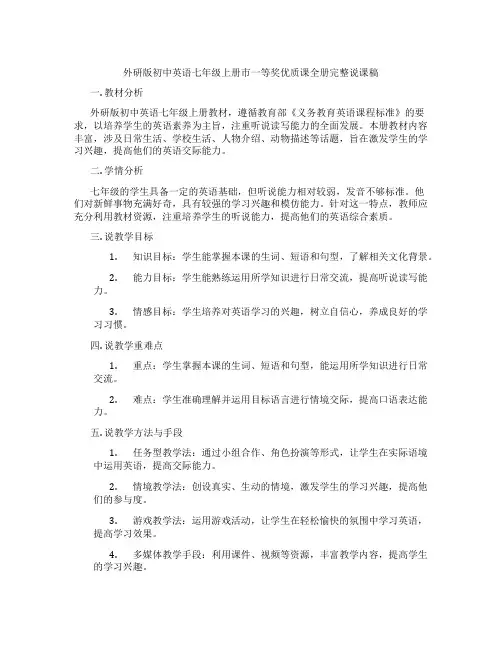
外研版初中英语七年级上册市一等奖优质课全册完整说课稿一. 教材分析外研版初中英语七年级上册教材,遵循教育部《义务教育英语课程标准》的要求,以培养学生的英语素养为主旨,注重听说读写能力的全面发展。
本册教材内容丰富,涉及日常生活、学校生活、人物介绍、动物描述等话题,旨在激发学生的学习兴趣,提高他们的英语交际能力。
二. 学情分析七年级的学生具备一定的英语基础,但听说能力相对较弱,发音不够标准。
他们对新鲜事物充满好奇,具有较强的学习兴趣和模仿能力。
针对这一特点,教师应充分利用教材资源,注重培养学生的听说能力,提高他们的英语综合素质。
三. 说教学目标1.知识目标:学生能掌握本课的生词、短语和句型,了解相关文化背景。
2.能力目标:学生能熟练运用所学知识进行日常交流,提高听说读写能力。
3.情感目标:学生培养对英语学习的兴趣,树立自信心,养成良好的学习习惯。
四. 说教学重难点1.重点:学生掌握本课的生词、短语和句型,能运用所学知识进行日常交流。
2.难点:学生准确理解并运用目标语言进行情境交际,提高口语表达能力。
五. 说教学方法与手段1.任务型教学法:通过小组合作、角色扮演等形式,让学生在实际语境中运用英语,提高交际能力。
2.情境教学法:创设真实、生动的情境,激发学生的学习兴趣,提高他们的参与度。
3.游戏教学法:运用游戏活动,让学生在轻松愉快的氛围中学习英语,提高学习效果。
4.多媒体教学手段:利用课件、视频等资源,丰富教学内容,提高学生的学习兴趣。
六. 说教学过程1.导入:利用多媒体展示与本课话题相关的图片或视频,引导学生进行观察和思考,激发学习兴趣。
2.呈现:教师通过实物、图片、课件等手段,展示本课的生词、短语和句型,让学生初步感知语言。
3.操练:学生分组进行角色扮演、小组讨论等活动,运用所学知识进行实际交流。
4.实践:教师创设真实情境,让学生在实际语境中运用英语,提高口语表达能力。
5.巩固:学生通过完成任务、游戏等活动,巩固所学知识,提高学习效果。
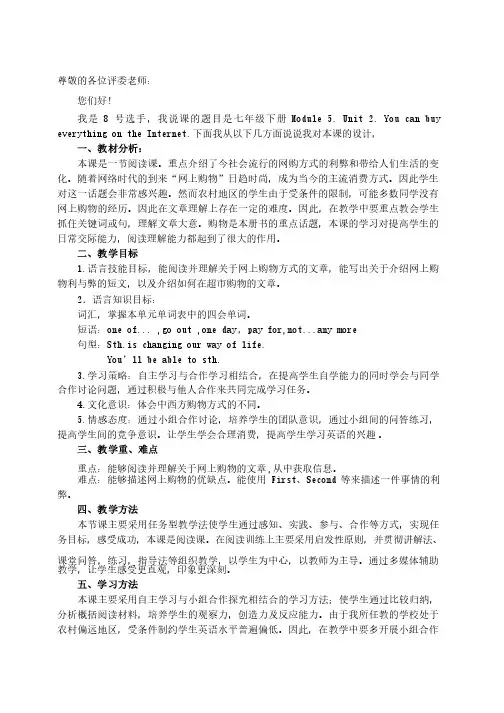
尊敬的各位评委老师:尊敬的各位评委老师:您们好!您们好!我是8号选手,我说课的题目是七年级下册Module 5. Unit 2. You can buy everything on the Internet.everything on the Internet.下面我从以下几方面说说我对本课的设计,下面我从以下几方面说说我对本课的设计,一、教材分析:本课是一节阅读课。
重点介绍了今社会流行的网购方式的利弊和带给人们生活的变化。
随着网络时代的到来“网上购物”日趋时尚,成为当今的主流消费方式。
因此学生对这一话题会非常感兴趣。
然而农村地区的学生由于受条件的限制,可能多数同学没有网上购物的经历。
因此在文章理解上存在一定的难度。
因此,在教学中要重点教会学生抓住关键词或句,理解文章大意。
购物是本册书的重点话题,本课的学习对提高学生的日常交际能力,阅读理解能力都起到了很大的作用。
二、教学目标1.1.语言技能目标,能阅读并理解关于网上购物方式的文章,能写出关于介绍网上购语言技能目标,能阅读并理解关于网上购物方式的文章,能写出关于介绍网上购物利与弊的短文,以及介绍如何在超市购物的文章。
2.语言知识目标:.语言知识目标:词汇,掌握本单元单词表中的四会单词。
短语:短语:one of... ,go out ,one day one of... ,go out ,one day one of... ,go out ,one day,,pay for,not...any more句型:句型:Sth.is changing our way of life. Sth.is changing our way of life.You You’’ll be able to sth.3.3.学习策略:自主学习与合作学习相结合,在提高学生自学能力的同时学会与同学学习策略:自主学习与合作学习相结合,在提高学生自学能力的同时学会与同学合作讨论问题,通过积极与他人合作来共同完成学习任务。
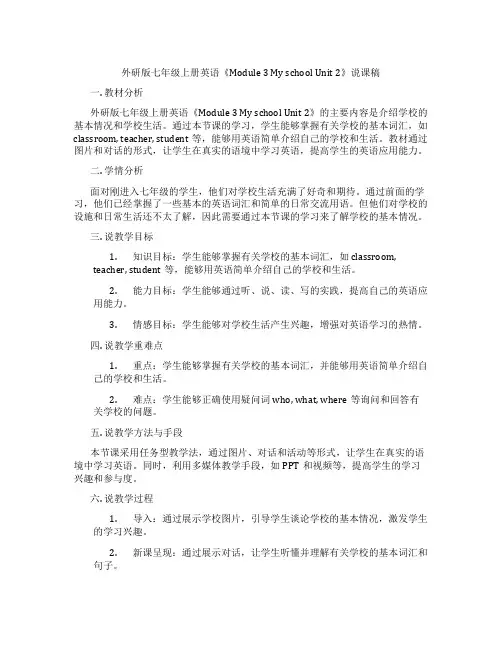
外研版七年级上册英语《Module 3 My school Unit 2》说课稿一. 教材分析外研版七年级上册英语《Module 3 My school Unit 2》的主要内容是介绍学校的基本情况和学校生活。
通过本节课的学习,学生能够掌握有关学校的基本词汇,如classroom, teacher, student等,能够用英语简单介绍自己的学校和生活。
教材通过图片和对话的形式,让学生在真实的语境中学习英语,提高学生的英语应用能力。
二. 学情分析面对刚进入七年级的学生,他们对学校生活充满了好奇和期待。
通过前面的学习,他们已经掌握了一些基本的英语词汇和简单的日常交流用语。
但他们对学校的设施和日常生活还不太了解,因此需要通过本节课的学习来了解学校的基本情况。
三. 说教学目标1.知识目标:学生能够掌握有关学校的基本词汇,如classroom,teacher, student等,能够用英语简单介绍自己的学校和生活。
2.能力目标:学生能够通过听、说、读、写的实践,提高自己的英语应用能力。
3.情感目标:学生能够对学校生活产生兴趣,增强对英语学习的热情。
四. 说教学重难点1.重点:学生能够掌握有关学校的基本词汇,并能够用英语简单介绍自己的学校和生活。
2.难点:学生能够正确使用疑问词who, what, where等询问和回答有关学校的问题。
五. 说教学方法与手段本节课采用任务型教学法,通过图片、对话和活动等形式,让学生在真实的语境中学习英语。
同时,利用多媒体教学手段,如PPT和视频等,提高学生的学习兴趣和参与度。
六. 说教学过程1.导入:通过展示学校图片,引导学生谈论学校的基本情况,激发学生的学习兴趣。
2.新课呈现:通过展示对话,让学生听懂并理解有关学校的基本词汇和句子。
3.操练:通过小组活动,让学生两人一组,用英语介绍自己的学校和生活。
4.巩固:通过完成任务,让学生运用所学知识,用英语书写有关学校的小短文。
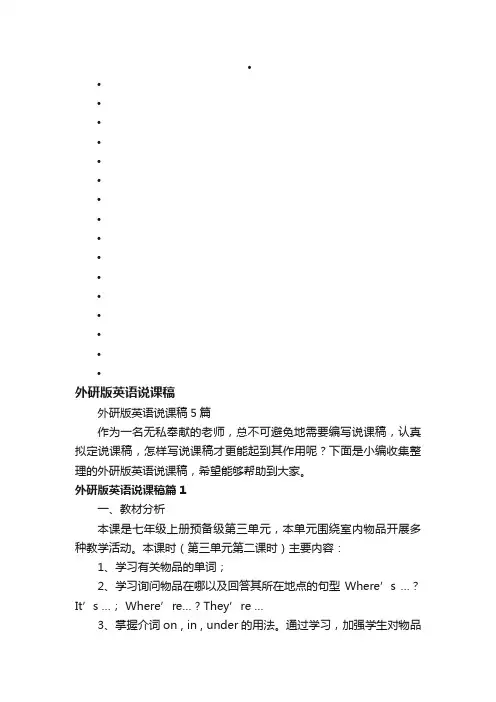
•••••••••••••••••外研版英语说课稿外研版英语说课稿5篇作为一名无私奉献的老师,总不可避免地需要编写说课稿,认真拟定说课稿,怎样写说课稿才更能起到其作用呢?下面是小编收集整理的外研版英语说课稿,希望能够帮助到大家。
外研版英语说课稿篇1一、教材分析本课是七年级上册预备级第三单元,本单元围绕室内物品开展多种教学活动。
本课时(第三单元第二课时)主要内容:1、学习有关物品的单词;2、学习询问物品在哪以及回答其所在地点的句型Where’s …?It’s …;Where’re… ? They’re …3、掌握介词on , in , under的用法。
通过学习,加强学生对物品名词、询问物品的句型及方位介词的理解和运用。
同时通过一系列的师生之间、学生之间的对话、操练、小组合作等,进一步提高学生的听、说、读、写的综合能力。
二、教学目标1、知识目标Vocabulary: bag , bed , cap , chair , coat , desk , shoes , where , on , in , under .Target language: Where’s my coat ? It’s in the bag on your desk .Prepositions: in , on , under .2、能力目标①To make the similar dialogues freely using the information offered . And so make the students improve their speaking , listening , reading and writing skills .②Train student’s communicative competence using the vocabulary and the target language .3、德育目标Students should take good care of the things . Help the students t o know that it’s a good habit to keep a room clean and tidy .三、教学重点和难点重点①The names of items .②How to ask where things are and how to answer .难点①Learn the usage of prepositions of place .②Make the students improve their listening , speaking , reading and writing skills .四、教学对象分析学情分析:学生对单元的活动内容有丰富的感性认识,贴近学生的生活实际,学生便于理解、感兴趣;初一学生活跃、好动,彼此间喜欢交流,因此,让学生观察生动形象的画面,更能激发他们的兴趣,提高学习的积极性。
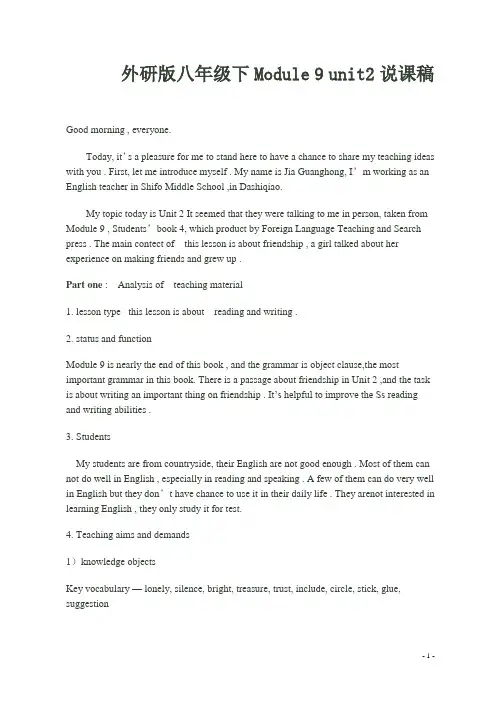
外研版八年级下Module 9 unit2说课稿Good morning , everyone.Today, it’s a pleasure for me to stand here to have a chance to share my teaching ideas with you . First, let me introduce myself . My name is Jia Guanghong, I’m working as an English teacher in Shifo Middle School ,in Dashiqiao.My topic today is Unit 2 It seemed that they were talking to me in person, taken from Module 9 , Students’book 4, which product by Foreign Language Teaching and Search press . The main contect of this lesson is about friendship , a girl talked about her experience on making friends and grew up .Part one : Analysis of teaching material1. lesson type this lesson is about reading and writing .2. status and functionModule 9 is nearly the end of this book , and the grammar is object clause,the most important grammar in this book. There is a passage about friendship in Unit 2 ,and the task is about writing an important thing on friendship . It’s helpful to improve the Ss reading and writing abilities .3. StudentsMy students are from countryside, their English are not good enough . Most of them can not do well in English , especially in reading and speaking . A few of them can do very well in English but they don’t have chance to use it in their daily life . They arenot interested in learning English , they only study it for test.4. Teaching aims and demands1)knowledge objectsKey vocabulary — lonely, silence, bright, treasure, trust, include, circle, stick, glue, suggestionKey structures — in silence, day by day2)ability objectsTo get information from the passage about friendship.To master the object clauses.3)moral objectsa. To arose Ss’ interest in learning English;b. To encourage Ss to be active in the activities and make Ss to be confident;c. To develop the ability to cooperate with others.5. teaching important points (a. To learn about some expressions in the passage..b. To learn about the object clauses.6. teaching difficult points1. To get information from the article.2.writing7. teaching aids (multi-media computer, software, OHP)The teaching syllabus says that it’s necessary for teachers to use modern teaching facilities. It’s of great help to increase the class density and improve our teaching result. It can also make the Ss reach a better understanding of the text by making the classes lively and interesting. At the same time, it arouses the Ss’ interest in learning English.Part Two :Teaching methodsFive step method; audio-video; communicative approach;Task-based learning: New Syllabus Design encourages teachers to use this teaching method. TBLT can stimulate Ss’ initiative in learning and develop their ability in language application. Make the Ss the real masters in class while the teacher himself acts as the director and bring their ability into full play.Part three : Study methods1. Teach Ss how to be successful language learners.2. Teach Ss how to develop the reading skill — skim & scan; how to communicate with others; how to learn new words; how to learn independently;3. Get the Ss to form good learning habits.Part four :Teaching proceduresTeaching Procedures:Step 1 RevisionAsk the student who’s ready to explain one of the word in module 9.Design purpose : To give Ss a chance to presentation themselves. This can help other students to remember the new words better.Step 2 Leading-inLook at the pictures and answer the questions.Design purpose :The pictures are from my own Ss, so they will like to see them.Step 3 Pre-readingWork in pairs and answer the four questions.1) When was the last time you feel sad?2) Who did you tell that you were sad?3) What did you do to feel better?4) How can you make other people feel happy?Step 4 Consolidate new wordsLook and say. The teachers shows the pictures of new words and let the students to say as soon as possible.Design purpose :To help Ss learn the new words . Ss can learn by themselves before the new lesson .Step 5 ListeningListen to Part 2 and answer the questions.1. How old was she when she went to a new school?2. What changed her life?Step 6 Reading1.Read the passage and answer the questions.1 Does the beginning of the passage surprise you? Why?Yes, it does. Because I don’t think a smile can be an important gift.2 How did the writer feel in the past?She felt very lonely.3 How does the writer feel now?She feels happy now.4 What advice does she give?Smile at the world and it will smile back.2. Find out the object clauses in the passage.1) I didn’t know who she was.2) One day, I asked her why she smiled at me that day.3) She said she could not remember!4) Now I believe that the world is what you think it is.3. Complete the sentences.Step 7 Learning to learnTo learn about the wh-questions while reading.When you read a story, focus on thefive wh-questions:•Who is the main character?•What happens?•When does the main event or story take place?•Where does it take place?•Why?Step 8 Complete the sentences with the words in the box1.Read the sentences carefully.1)My father made the _________ that I should find a hobby.2)Even today, some people search for _________ under the sea.3)You can _______ them to look after the house.4)You must make the stamp wet before you ______ it to the letter.5)Have you got any _______? I want to stick these pieces of paper together.6)John’s _______ of friends includes some students from the UK.7)I like the _______ in the countryside. The city is too noisy for me!2.Choose the right words to fill in the blanks.Step9 Writing1. Read the passage again. Find the paragraphs that describe the following stages. What happened and when.Where she was and how she feltWhy she felt that way.What happened one day.What happened suddenly.What happened after this.What happened later.What she thinks now.2. Write a passage about someone or something that changed your life. Use the stages in Activity 5 to help you.Step 10 SummaryLet Ss talk about what they have learnt in class.•whether/if及疑问词引导的宾语从句•重点短语in silenceday by dayevery timeStep 11 ExercisesLet the students practice the main points in Unit 2.1. ____ I read the novel, I felt the touch of something.A. Every timeB. EverytimeC. Every times2. The boy felt _____ when he stayed at home alone.A. aloneB. lonelyC. happily3. The little boy grew up day ____ day.A. atB. toC. forD. by4. I want to give you some _____ about the hobby.A. suggestB. suggestionC. advicesD. piece of advicesStep 12 中考链接Do some exercises from the entrance exam to senior high schools.1.The policewoman asked the little boy ______. 【2012贵州安顺】A. where did he liveB. where he livedC. where he livesD. where does he lives2. -- Could you tell me_____ he came here?--He drove here himself. 【2012 安徽省】A. howB. whyC. whenD. whether3. --Can you tell me ____ the prize, Tom?--Last year. 【2012北京】A. when you gotB. when did you getC. when will you getD. when you will get4. --Could you tell me _______?--Certainly. In half an hour.【2012广东】A.when will the high speed train arriveB. when the high speed train will arriveC. when would the high speed train arriveD. when the high speed train would arriveStep 13 Homework给老师写一封电子邮件,介绍你交友方面遇到的问题。
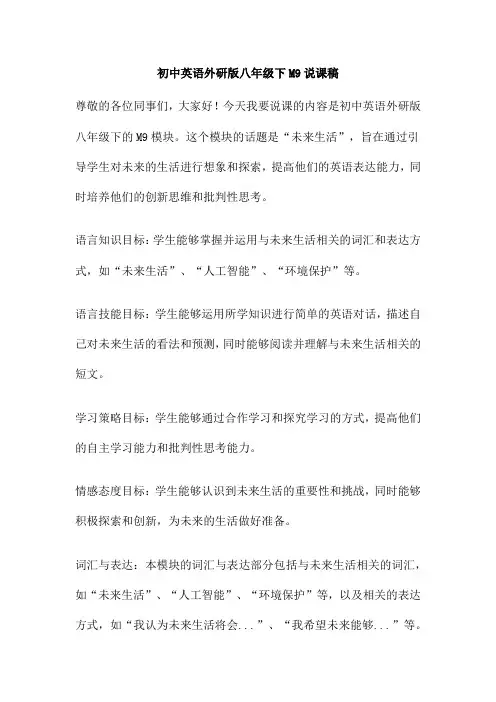
初中英语外研版八年级下M9说课稿尊敬的各位同事们,大家好!今天我要说课的内容是初中英语外研版八年级下的M9模块。
这个模块的话题是“未来生活”,旨在通过引导学生对未来的生活进行想象和探索,提高他们的英语表达能力,同时培养他们的创新思维和批判性思考。
语言知识目标:学生能够掌握并运用与未来生活相关的词汇和表达方式,如“未来生活”、“人工智能”、“环境保护”等。
语言技能目标:学生能够运用所学知识进行简单的英语对话,描述自己对未来生活的看法和预测,同时能够阅读并理解与未来生活相关的短文。
学习策略目标:学生能够通过合作学习和探究学习的方式,提高他们的自主学习能力和批判性思考能力。
情感态度目标:学生能够认识到未来生活的重要性和挑战,同时能够积极探索和创新,为未来的生活做好准备。
词汇与表达:本模块的词汇与表达部分包括与未来生活相关的词汇,如“未来生活”、“人工智能”、“环境保护”等,以及相关的表达方式,如“我认为未来生活将会...”、“我希望未来能够...”等。
在教学中,我将采用语境教学的方法,通过创设情境和角色扮演等方式,帮助学生掌握并运用这些词汇和表达方式。
对话与短文:本模块的对与短文部分包括一些关于未来生活的对话和短文。
通过阅读和理解这些对话和短文,学生能够更好地了解未来生活的可能性和挑战。
在这部分教学中,我将采用问题式教学的方法,引导学生通过思考和讨论的方式理解并掌握文章的主旨和要点。
探究与创造:本模块的探究与创造部分旨在引导学生通过合作学习和探究学习的方式,对未来生活进行想象和探索。
在这部分教学中,我将采用项目式学习的方法,通过设定主题和任务,引导学生进行小组探究和创造,培养他们的创新思维和批判性思考能力。
课堂表现:通过观察学生的课堂表现,如参与度、注意力、回答问题等情况,了解他们对本模块内容的掌握情况。
作业:布置与本模块内容相关的作业,如写一篇关于未来生活的短文、设计一个未来生活的场景等,了解学生对本模块内容的理解和应用情况。
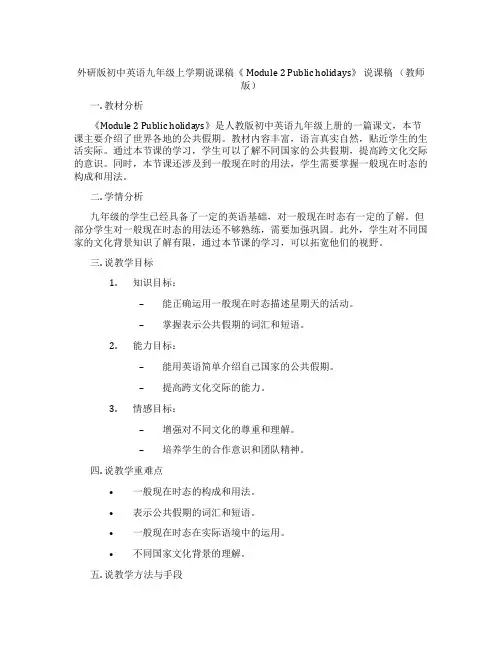
外研版初中英语九年级上学期说课稿《 Module 2 Public holidays》说课稿(教师版)一. 教材分析《Module 2 Public holidays》是人教版初中英语九年级上册的一篇课文,本节课主要介绍了世界各地的公共假期。
教材内容丰富,语言真实自然,贴近学生的生活实际。
通过本节课的学习,学生可以了解不同国家的公共假期,提高跨文化交际的意识。
同时,本节课还涉及到一般现在时的用法,学生需要掌握一般现在时态的构成和用法。
二. 学情分析九年级的学生已经具备了一定的英语基础,对一般现在时态有一定的了解。
但部分学生对一般现在时态的用法还不够熟练,需要加强巩固。
此外,学生对不同国家的文化背景知识了解有限,通过本节课的学习,可以拓宽他们的视野。
三. 说教学目标1.知识目标:–能正确运用一般现在时态描述星期天的活动。
–掌握表示公共假期的词汇和短语。
2.能力目标:–能用英语简单介绍自己国家的公共假期。
–提高跨文化交际的能力。
3.情感目标:–增强对不同文化的尊重和理解。
–培养学生的合作意识和团队精神。
四. 说教学重难点•一般现在时态的构成和用法。
•表示公共假期的词汇和短语。
•一般现在时态在实际语境中的运用。
•不同国家文化背景的理解。
五. 说教学方法与手段1.教学方法:–任务型教学法:通过完成各种任务,激发学生的学习兴趣,提高学生的参与度。
–交际型教学法:通过小组讨论、角色扮演等形式,培养学生的交际能力。
2.教学手段:–多媒体教学:利用PPT、视频等手段,丰富教学内容,提高学生的学习兴趣。
–网络资源:利用网络资源,让学生了解不同国家的公共假期,拓宽视野。
六. 说教学过程•教师通过提问,引导学生谈论自己喜欢的公共假期,激发学生的学习兴趣。
•教师展示各国公共假期的图片,引导学生用英语进行描述。
•学生分组,每组选择一个国家的公共假期,用英语进行介绍。
•学生模拟在国外旅游,用英语交流各国公共假期的信息。
•教师引导学生总结本节课所学内容,加深记忆。
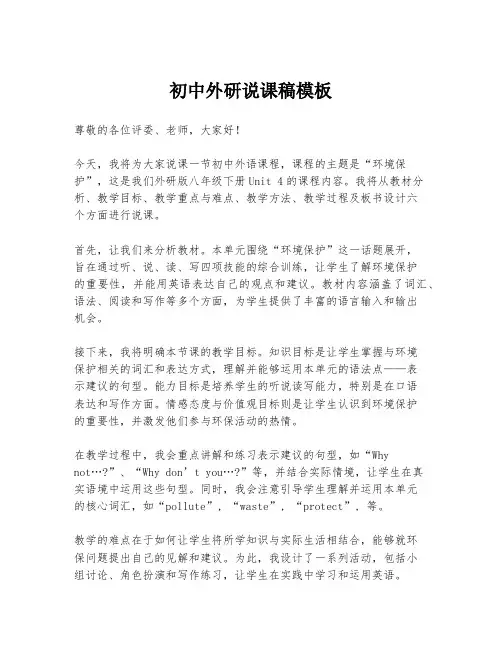
初中外研说课稿模板尊敬的各位评委、老师,大家好!今天,我将为大家说课一节初中外语课程,课程的主题是“环境保护”,这是我们外研版八年级下册Unit 4的课程内容。
我将从教材分析、教学目标、教学重点与难点、教学方法、教学过程及板书设计六个方面进行说课。
首先,让我们来分析教材。
本单元围绕“环境保护”这一话题展开,旨在通过听、说、读、写四项技能的综合训练,让学生了解环境保护的重要性,并能用英语表达自己的观点和建议。
教材内容涵盖了词汇、语法、阅读和写作等多个方面,为学生提供了丰富的语言输入和输出机会。
接下来,我将明确本节课的教学目标。
知识目标是让学生掌握与环境保护相关的词汇和表达方式,理解并能够运用本单元的语法点——表示建议的句型。
能力目标是培养学生的听说读写能力,特别是在口语表达和写作方面。
情感态度与价值观目标则是让学生认识到环境保护的重要性,并激发他们参与环保活动的热情。
在教学过程中,我会重点讲解和练习表示建议的句型,如“Why not…?”、“Why don’t you…?”等,并结合实际情境,让学生在真实语境中运用这些句型。
同时,我会注意引导学生理解并运用本单元的核心词汇,如“pollute”, “waste”, “protect”, 等。
教学的难点在于如何让学生将所学知识与实际生活相结合,能够就环保问题提出自己的见解和建议。
为此,我设计了一系列活动,包括小组讨论、角色扮演和写作练习,让学生在实践中学习和运用英语。
在教学方法上,我将采用任务型教学法和合作学习法。
通过设计贴近学生生活的任务,激发学生的学习兴趣和参与热情。
同时,通过小组合作,培养学生的团队协作能力和沟通技巧。
教学过程分为以下几个步骤:1. 热身活动:通过播放一段关于环境保护的视频,引起学生的兴趣,并引导学生进行简单的讨论,激活学生的背景知识。
2. 词汇和句型呈现:结合图片和情境,引入新词汇和句型,并进行操练。
3. 听力练习:播放一段关于环保的对话,让学生听后回答问题,检验学生对新词汇和句型的掌握情况。
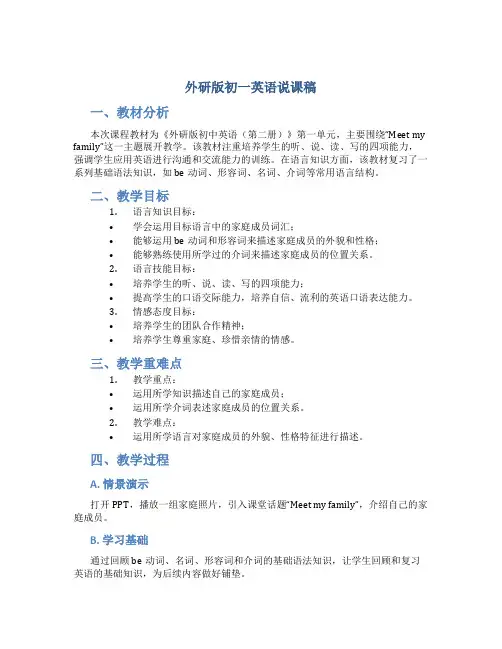
外研版初一英语说课稿一、教材分析本次课程教材为《外研版初中英语(第二册)》第一单元,主要围绕“Meet my family”这一主题展开教学。
该教材注重培养学生的听、说、读、写的四项能力,强调学生应用英语进行沟通和交流能力的训练。
在语言知识方面,该教材复习了一系列基础语法知识,如be动词、形容词、名词、介词等常用语言结构。
二、教学目标1.语言知识目标:•学会运用目标语言中的家庭成员词汇;•能够运用be动词和形容词来描述家庭成员的外貌和性格;•能够熟练使用所学过的介词来描述家庭成员的位置关系。
2.语言技能目标:•培养学生的听、说、读、写的四项能力;•提高学生的口语交际能力,培养自信、流利的英语口语表达能力。
3.情感态度目标:•培养学生的团队合作精神;•培养学生尊重家庭、珍惜亲情的情感。
三、教学重难点1.教学重点:•运用所学知识描述自己的家庭成员;•运用所学介词表述家庭成员的位置关系。
2.教学难点:•运用所学语言对家庭成员的外貌、性格特征进行描述。
四、教学过程A. 情景演示打开PPT,播放一组家庭照片,引入课堂话题“Meet my family”,介绍自己的家庭成员。
B. 学习基础通过回顾be动词、名词、形容词和介词的基础语法知识,让学生回顾和复习英语的基础知识,为后续内容做好铺垫。
C. 学习新知1.通过例句和图片复习家庭成员的词汇。
•mother/mum, father/dad, brother, sister, grandparents, uncle, aunt, cousin。
2.通过图片介绍家庭成员的外貌特征和性格特征,帮助学生复习、巩固形容词的基础知识。
3.通过图片和口语练习介词的使用方法,让学生熟悉和运用介词来表述家庭成员的位置关系。
D. 学习任务1.分组让学生互相介绍自己的家庭成员,要求形式多样,例如口语表达、图示绘画、写作等形式。
2.分组讨论“家庭成员的性格特征”,并用英语口语描述。
外研版九年级英语下册说课稿《Module 3 Unit 2 I think life is better today》一. 教材分析《Module 3 Unit 2 I think life is better today》是人教版九年级英语下册的一篇文章,主要讨论了人们对于现代社会生活的看法。
文章通过描述不同人对于生活的不同看法,让学生了解到生活的变迁和社会的发展。
本节课的主要内容包括阅读理解、词汇学习和语法讲解。
在阅读理解部分,学生需要通过阅读文章,理解文章的主旨大意,掌握文章中的关键信息。
词汇学习部分主要是对文章中出现的一些重点词汇进行学习和讲解。
语法讲解部分主要是对文章中的语法现象进行分析和解释。
二. 学情分析九年级的学生已经具备了一定的英语基础,对于阅读理解、词汇学习和语法讲解都有了一定的了解。
但是,由于学生的英语水平参差不齐,对于一些复杂的句子结构和语法现象可能还不是很理解。
因此,在教学过程中,需要根据学生的实际情况,进行有针对性的教学。
三. 说教学目标1.知识目标:通过本节课的学习,学生能够掌握文章中的重点词汇和语法现象。
2.能力目标:通过本节课的学习,学生能够提高阅读理解能力,能够快速准确地获取文章中的关键信息。
3.情感目标:通过本节课的学习,学生能够了解到生活的变迁和社会的发展,增强对生活的热爱和对社会的责任感。
四. 说教学重难点1.教学重点:文章中的重点词汇和语法现象。
2.教学难点:对于一些复杂的句子结构和语法现象的理解和运用。
五. 说教学方法与手段在本节课的教学过程中,我将采用任务型教学法和情境教学法。
任务型教学法可以帮助学生提高阅读理解能力,快速准确地获取文章中的关键信息。
情境教学法可以让学生在实际情境中学习英语,提高学生的实际运用能力。
此外,我还将利用多媒体教学手段,如图片、视频等,来帮助学生更好地理解和掌握知识。
六. 说教学过程1.导入:通过展示一些图片,如过去和现在的对比,让学生谈论一下生活的变化,引出本节课的主题。
外研社版初中英语写作说课稿Writing is an essential skill for students to develop in their English language learning journey. The English textbook published by the Foreign Language Teaching and Research Press (FLTRP) for junior high schools in China places a strong emphasis on cultivating students' writing abilities. This teaching plan outlines an approach to effectively deliver a writing lesson using the resources provided in the FLTRP junior high school English textbook.The lesson aims to guide students through the process of writing a descriptive paragraph about their favorite season. This topic is covered in Unit 5 of the textbook, which focuses on the theme of "Seasons and Weather". By the end of the lesson, students will be able to produce a well-structured descriptive paragraph that effectively conveys their thoughts and feelings about their favorite season.To begin the lesson, the teacher will engage students in a warm-up activity to activate their prior knowledge and build excitement for the writing task. The teacher may ask students to share their favoriteseason and explain why they enjoy it. This discussion will help students generate ideas and vocabulary related to the topic of seasons.Next, the teacher will introduce the writing task and provide clear instructions. Students will be asked to write a descriptive paragraph about their favorite season, using the model paragraph provided in the textbook as a reference. The teacher will emphasize the importance of including sensory details, such as descriptions of sights, sounds, smells, and temperatures, to create a vivid and engaging paragraph.Before students start writing, the teacher will guide them through a brainstorming activity. Students will be encouraged to jot down their thoughts, feelings, and memories associated with their favorite season. This will help them organize their ideas and develop a clear focus for their paragraph.Once the brainstorming is complete, students will begin drafting their paragraphs. The teacher will circulate the classroom, providing individual support and feedback as needed. Students will be encouraged to refer to the language structures and vocabulary presented in the textbook to enhance their writing.After the initial drafting phase, the teacher will introduce the conceptof peer review. Students will be paired up to read each other's paragraphs and provide constructive feedback. The teacher will provide a peer review checklist to guide students in their feedback, focusing on elements such as organization, use of descriptive language, and overall effectiveness of the paragraph.With the peer feedback in hand, students will have the opportunity to revise and refine their paragraphs. The teacher will emphasize the importance of the revision process, encouraging students to consider their peers' suggestions and make necessary improvements to their writing.Finally, the teacher will invite several students to share their revised paragraphs with the class. This will allow students to celebrate their accomplishments and gain inspiration from their classmates' work. The teacher may also provide whole-class feedback and highlight exemplary aspects of the paragraphs presented.Throughout the lesson, the teacher will utilize various instructional strategies to cater to different learning styles and engage students. These may include the use of visual aids, such as images or video clips related to the seasons, to stimulate students' creativity and imagination. Additionally, the teacher may incorporate pair or group activities to foster collaboration and peer learning.By following this teaching plan, the teacher will effectively guide students through the writing process, from brainstorming to revision, while leveraging the resources provided in the FLTRP junior high school English textbook. This approach will not only develop students' writing skills but also foster their critical thinking, creativity, and collaborative abilities – all essential components of a well-rounded English language education.。
外研版英语说课稿外研版英语说课稿「篇一」各位老师:大家好!让学生愉快地、充满自信地走进我的英语课堂,是我最大的愿望,让学生在我的英语课堂上享受快乐和成功是我孜孜以求的。
我为实现自己的梦想和追求不懈地努力着。
今天,借此平台,愿与大家一起分享我的说课,让我们一起探讨,共同成长。
我说课的内容是牛津小学英语4A Unit6 Whose gloves?第二课时。
一.说教材教学内容本单元的话题是寻找物主,要求学生围绕服饰类的英语单词,在一定的情景下,能正确使用Whoes is this/are they?进行交谈。
在学习完第一课时的基础上,我确定了本课时的教学内容为:A(4-6),B :a pair of shorts,a scarf,a aweater,ajacket,C:Whoseis it/are they?It’s/They’re xxx’s。
教材地位本课时中出现的xxx’s,在前面的第三单元中已有所接触,可以说是Unit3的知识延续,具有承上启下的作用。
服饰类单词的单复数使用更是对今后的单复数学习有着重要作用。
根据《英语课程标准》的教学理念,教材特点以及四年级学生的实际情况,本课的教学目标确立为:知识目标1.能够听、说、读a pair of shorts,a scarf,四会a sweater,a jacket 2.能够听懂、会说、会读、会写本课时的主要句型:Whoseis this/are they?It’s/They’re并能在适合的情景中自由运用。
3.能够跟录音朗读对话,并能分角色进行表演。
能力目标1.要求学生能围绕服饰类单词,在一定情景下,正确使用Whoseis it/are they?及回答It’s /They’re xxx’s.进行交谈。
情感目标1.培养学生良好的学习习惯和形成有效的学习策略。
2.培养学生对美的鉴赏和认识。
在仔细研究教材和分析学生的心理和生理特点的基础上,我认为本课重点是掌握有关寻找失主的句型:Whoseis this/are they? It’s /They are xxx’s.等有关服饰的表达法。
初中外语外研版说课稿经典案例汇总模板初中英语说课稿(英文版)模板一、说教材(教材分析)Analyzing teaching material1. 说课型lesson type (Dialogue/ reading/ listening/ revision)2. 本课在教材中的地位status and functionLesson 33 Saving the Earth is a dialogue. The lesson is focused on the topic of the problems of the earth and the functional items of Supposition/ Intentions/ conjecture/ Prohibition. Since it is a dialogue / reading. It’s helpful to improve the Ss communicative/ reading ability.3. 说教学指导思想teaching guideline(Teaching syllabus: Language is for communication, develop their four skills, lay special emphasis on reading; Grellet put it well in his book developing reading skills: develop reading skill/ discourse analysis; get them to understand the western culture better; improve the ability to discover, analyze & solve the problems; Reading is for information, for fun; Use Top- down model or Bottom- up model to activate Ss schemata; Interactive model)4. 说教学目标和要求Teaching aims and demands (…be intended for Ss in key schools)1)认知目标knowledge objectsa. Enable the Ss to remember the following new words & phrases:Damage, lecture, pollute, pollution, room, standing room, be fit for, hear about, turn intob. Get the Ss to be familiar with this sentence pattern:If the population keeps growing so quickly, there will only be standing room left…Give the Ss a reinforced practice on the functional item Supposition.c. Activate Ss schemata regarding the topic of pollution and help Ss to know more about the problem of pollution.2)智能目标ability objectsa. Ask the Ss to make up a similar dialogue.b. Help them to understand the dialogue better and improve the four skills.c. Develop their ability of thinking independently.d. Cultivate their ability to discover, analyze and solve problems.e. Train them to collect information from the Internet.f. Train them with some effective learning methods to optimize Ss’ learning results.3)德育目标moral objectsa. Arouse their interest in learning English;b. Help them to understand the background of pollution.c. Enable the students to love our earth and the nature.d. Be aware of the importance of stopping pollution & protecting our environment.e. Encourage the Ss to do something to save the earth.5. 说教学重点teaching important points (生词、句型;培养阅读技能)a. New words and phrasesb. Sentence pattern: If- clausec. improve their reading skills.d. Talking about problems of the Earth.6. 说教学难点teaching difficult points (语法;发展交际能力)a. functional item: Supposition.b. Develop their communicative ability. Act out their own dialogue.7. 说教具teaching aids (multi-media computer, software, OHP)The teaching syllabus says that it’s necessary for teachers to use modern teaching facilities. It’s of great help to increase the classdensity and improve our teaching result. It can also make the Ss reach a better understanding of the text by making the classes lively and interesting. At the same time, it arouses the Ss’ interest in learning English.二、说教法Teaching methodsFive step method; audio-video; communicative approach;Task-based learning: New Syllabus Design encourages teachers to use this teaching method. TBLT can stimulate Ss’ initiative in learning and develop their ability in language application. Make the Ss the real masters in class while the teacher himself acts as the director and bring their ability into full play.三、说学法Study methods1. Teach Ss how to be successful language learners.2. Teach Ss how to develop the reading skill — skim & scan; how to communicate with others; how to learn new words; how to learn independently;3. Get the Ss to form good learning habits.四、说教学过程Teaching proceduresI. 复习(Revision) 5min (Daily report; 词汇diagram; brainstorming; activate schemata)Activity 1: Imagination1). Suppose a bottle of ink is turned over and dirties your whiteshirt, what is to be done? (Wash it? Or throw it away?)2). Suppose you catch a bad cold, what’s to be done?3). Suppose your bike is broken, what’s to be done?4). And suppose the earth, on which we all live, is damaged, what’s to be done?* What can you think of when yo u see “pollution” thisword?(waste, environment, air, water, factory, desert, climate... Try to activate the Ss schemata regarding the topic of pollution.) II. 呈现(Presentation) 5minActivity 2: PresentationPlay the song “Earth Song” sung by Michael Jacks on. (Create an atmosphere)A lot of pictures and video clips about the causes and results of the three problems mentioned in this lesson will be shown on the screen with the help of the computer.Ss’ presentation on pollution. Attract their attention, arou se their interest, and create a good atmosphere for communication.* Activate their schemata and cultivate their ability in collecting information from the Internet and develop their ability in thinking independently.III. 对话/ 阅读(Dialogue)18m1. Pre- readingActivity 3: Prediction1st listening/ fast reading, one guided Q to help Ss to get the main idea:What do you think is discussed at the conference?2. While- readingActivity 4: Read and answer2nd listening/ careful reading, more Qs to get the detailed information. Develop their reading skills: skim & scan. Pay attention to the pronunciation, stress & intonation.* 阅读: Pre-reading; while-reading; post-reading (fast reading/ careful reading; skim/ scan; 识别关键词key words;确定主题句;创设信息差information gap;T or F; 填表格chart/diagram; Predicting; Make a timeline; Make a story map。
外研版初二英语上Module 7Unit 1 That smells delicious! 说课稿 各位老师,大家好!今天我说课的内容为外研版初二英语上第七模块第一单元。我将从教材分析、学情分析、教学方法、教学目标、教学重点难点、教学步骤六个方面进行阐述。
一、教材分析: 1.本模块以感觉与印象为中心话题,内容分为两部分:对话——主要以表感觉和知觉的系动词的用法为主,表达对食物或事物的感觉评论;阅读课文——Sally一封信,对英国女孩Sally印象进行了描述。学会表达It/sth smells/tastes/feels/looks/sounds…并在此基础上学会一些描述人长相和性格的表达方式,包括句式和一些形容词。本课教学内容与学生的实际生活密切相关,易于引发学生运用简单的英语进行交际和交流。这些内容都很符合这一年龄段的学生的兴趣。在学习活动中,学生通过交换对某些事物或某人的描述及看法,促进学生之间和师生之间的情感交流,增进情谊。。
2.本节课的教学内容是第七模块的第一节课。这本教材的第一课以培养学生的听说能力为主,兼顾读写,并包括词汇,语法,语音的学习活动。这是学生第一次接触到表感觉和知觉的系动词。在本课中要让学生初步感知系动词的用法,我就用孩子们身边的人或物让学生们通过看,听,尝,闻,感觉来切身的感知这些系动词,使学生能够运用系动词来表达自己的感受。教材安排了许多听,说,读,写的任务活动,我将灵活运用这些活动,将其中的一些活动进行变化或整合,如我将Activity1和Activity2顺序颠倒一下,先让学生看图或实物说句子,在做听力部分。 学情分析 1.初中学生的抽象思维能力较低,形象思维能力强,但注意力容易分散。本课拟以故事、实物、图片,猜谜语等形式展示,并配以丰富的色彩,从而增强学生的兴趣和注意力。根据教育心理学,如果学生对于一件事物有极大的兴趣,他们就会排除主观和客观的种种消极因素,尽量全身心地投入到知识的学习中去。
2.初二上学期的学生经过一年多的学习,有了一定的英语基础知识和听说能力,正逐渐向读、写过渡,同时,学生们对英语学习还保持着较浓厚的兴趣。经过一年的新课程理念的熏陶及实践,有了初步的自主、合作、探究、实验的能力。
3.本单元学情剖析:本单元的主题是谈论感觉与印象,可以采用活动教学法和Role playing的学习策略,学习新词汇,掌握重点句型,同时能比较好地运用到实践中,解决类似问题。做到既能巩固所学知识,又能提高解决问题的能力以及综合运用语言能力。
教学方法: 1,任务型语言教学法 在教师精心设计的各种“任务”中,学生能够不断地获得知识或得出结论,从注重语言本身转变为注重语言习得。从而获得语言运用的能力而不是仅仅掌握现成的语言知识点。随着“任务”的不断深化,整个语言学习的过程会越来越自动化和自主化。在本课的任务型语言教学中,我将依据课程的总体目标并结合教学内容,创造性地设计贴近学生生活实际的任务活动,吸引和组织他们积极参与,使学生通过观察、思考、讨论、交流和合作等方式,在一种自然、真实或模拟真实的情境中体会语言、掌握语言的应用。
2, 情景交际法 课堂教学以情景交际教学法为主,尽量给学生以足够的听、说、读的机会,联系课文实际,创设情景,引入讨论主题,在交际中学英语。情景的设计注意衔接的自然性,主题的设计强调知识的渐进性和讨论的可行性,并注意情感体验和概括、推理思维的培养
3, 多媒体辅助 将本课所需要的录音、图片、文字、和音乐制成课件,使抽象的语言变得直观,为学生运用英语进行交际创设情景,实现师生互动,生生互动和人机互动的多向交流。
学法指导 1、学习方法的指导 培养学生观察力,想象力,记忆力以及思维能力。用生动的课件调动学生的感官进行听说读写的训练。
2、学习积极性的调动 我在教学过程中创造一种开放的,和谐的,积极互动的语言氛围,把课堂变成有声有色的舞台,让学生在乐中学。 3、学习能力的培养 通过连贯的听说读写,游戏,竞赛等,培养学生的交际能力,发展他们的思维能力。
4、学习策略的指导 本节课将在课堂活动中把学生分成四人小组的学习小组,让他们围绕着课堂任务分工合作,在活动中相互探讨、相互交流、相互合作,从而获得知识、技能和情感体验,发展他们的能力。我让学生观察课件画面,回答问题,让学生学会使用认知策略;让学生表演对话,实现交际策略;引导学生交际,主动练习和实践,是调控策略的体现。充分利用多媒体,录音,卡片等是资源策略。
教学目标: 基于对教材的分析,同时为了更好地培养学生学习英语的兴趣,提高应用英语能力,推进探究﹑合作和自主学习,我将本节课的三维目标及重难点确定如下:
知识与能力:1.听,读懂含有系动词的句子和对话。 2.能够正确朗读系表结构的句子。 3.会运用含有系动词的句子来表达自己的感觉。 过程与方法:围绕话题进行听,说和讨论,并会和同伴交流 情感态度与价值观:通过阅读他人的自我描述,更好地理解别人,从而更好的懂得关心别人。
重点:学习表感觉和知觉的系动词,学会一些描述人长相和性格的表达方式。句式:sb/sth feels/smells/sounds/looks/tastes…
难点: link verb + adj, What’s she like与 What does she look like的区别
教学步骤 活动内容 设计思路 Stept1 Warming up 1. Listening to a song . Listen to an English song Jingle Bells, let the students do the action while they are listening. 歌曲欣赏,以学生喜闻乐见的形式导入新课,为学生创造轻松愉快的学习气氛, 激发学生的好奇心,为学习新课打下伏笔。
2Games:Play a game :touch your nose .Call one student to the front ,say “touch your nose /hand /eye/ear/mouth”.Then let the other students do。通过游戏的方式来调动学生的积极性,培养学生的兴趣,并巩固这些感觉器官的名称,为以下的感官系动词打下基础。全感官的参与使记忆更加顺畅。这样的活动能使学生在轻松活泼的气氛中学习和掌握知识。
Step2 presentation 1, 教师: Do you like this music I like it very much .it sounds lively .And I feel very happy .Do your feel happy ?
学生: Yes ,I do . It sounds lively. 同样方法用糖果、毛巾、醋、班中的学生来练习,It feels /tastes/smells…….The boy looks ……
由上一环节自然过渡到新课的学习,让学生根据实物和身边的人来亲自体验系动词的用法。学生在不知不觉中感知新知识;保持学习新知识的兴趣。
2 Practicing look at some pictures of activity 1,Let Ss say some do activity 2,Match the sentences with the pictures.。这样让学生根据上一环节进一步练习。
3. Listening. Play the tape of 1b twice for Ss to listen and follow. Then get them to number the pictures . 本环节是教材安排的任务型听力活动,目的是让学生在听音时抓住关键词,培养学生边听边做笔记的学习策略。
4巩固练习 Look at some pictures .and say A: The chocolate cookies taste delicious. B: The sweater feels soft and comfortable .The jeans feel tight . C The cheese doesn’t smell fresh.
D: They look strong. Zhang Baizhi looks pretty and smart .
利用课件中的图片,使抽象的语言变得直观,为学生运用英语进行交际创设情景,
Step3 listen and read 1 整体听一遍,回答问题。从整体上感知全文 2再听一遍,注意生词及含有系动词的句式 3语法展示link verb +adj 及Everyday English 4读课文 5 Group work :四人一小组,有感情的分角色朗读课文。然后找两组读对话,注意表情
6 Do activity 5 .Complete the sentences .小组内讨论的形式 让学生在小组中交流、合作。易于激发学生的表达欲望,在活动中他们一定会努力表现自己,做到最好。把任务活动放在小组中进行,还可以解决“大班”难于操练的难题,学生在小组中有更多的时间来运用英语表达自己的思想。